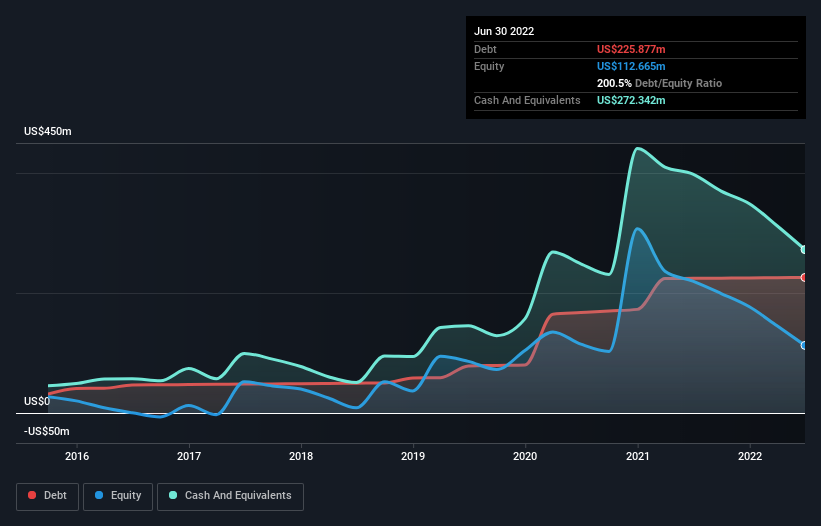Does NanoString Technologies (NASDAQ:NSTG) Have A Healthy Balance Sheet?
David Iben put it well when he said, 'Volatility is not a risk we care about. What we care about is avoiding the permanent loss of capital.' When we think about how risky a company is, we always like to look at its use of debt, since debt overload can lead to ruin. We note that NanoString Technologies, Inc. (NASDAQ:NSTG) does have debt on its balance sheet. But the more important question is: how much risk is that debt creating?
When Is Debt Dangerous?
Generally speaking, debt only becomes a real problem when a company can't easily pay it off, either by raising capital or with its own cash flow. Part and parcel of capitalism is the process of 'creative destruction' where failed businesses are mercilessly liquidated by their bankers. However, a more common (but still painful) scenario is that it has to raise new equity capital at a low price, thus permanently diluting shareholders. Having said that, the most common situation is where a company manages its debt reasonably well - and to its own advantage. When we think about a company's use of debt, we first look at cash and debt together.
View our latest analysis for NanoString Technologies
What Is NanoString Technologies's Debt?
The chart below, which you can click on for greater detail, shows that NanoString Technologies had US$225.9m in debt in June 2022; about the same as the year before. But on the other hand it also has US$272.3m in cash, leading to a US$46.5m net cash position.
How Strong Is NanoString Technologies' Balance Sheet?
The latest balance sheet data shows that NanoString Technologies had liabilities of US$51.8m due within a year, and liabilities of US$248.9m falling due after that. Offsetting this, it had US$272.3m in cash and US$31.4m in receivables that were due within 12 months. So these liquid assets roughly match the total liabilities.
Having regard to NanoString Technologies' size, it seems that its liquid assets are well balanced with its total liabilities. So it's very unlikely that the US$716.0m company is short on cash, but still worth keeping an eye on the balance sheet. Simply put, the fact that NanoString Technologies has more cash than debt is arguably a good indication that it can manage its debt safely. The balance sheet is clearly the area to focus on when you are analysing debt. But it is future earnings, more than anything, that will determine NanoString Technologies's ability to maintain a healthy balance sheet going forward. So if you want to see what the professionals think, you might find this free report on analyst profit forecasts to be interesting.
Over 12 months, NanoString Technologies reported revenue of US$143m, which is a gain of 7.0%, although it did not report any earnings before interest and tax. We usually like to see faster growth from unprofitable companies, but each to their own.
So How Risky Is NanoString Technologies?
We have no doubt that loss making companies are, in general, riskier than profitable ones. And in the last year NanoString Technologies had an earnings before interest and tax (EBIT) loss, truth be told. And over the same period it saw negative free cash outflow of US$104m and booked a US$139m accounting loss. While this does make the company a bit risky, it's important to remember it has net cash of US$46.5m. That kitty means the company can keep spending for growth for at least two years, at current rates. Even though its balance sheet seems sufficiently liquid, debt always makes us a little nervous if a company doesn't produce free cash flow regularly. There's no doubt that we learn most about debt from the balance sheet. However, not all investment risk resides within the balance sheet - far from it. For example - NanoString Technologies has 2 warning signs we think you should be aware of.
When all is said and done, sometimes its easier to focus on companies that don't even need debt. Readers can access a list of growth stocks with zero net debt 100% free, right now.
Have feedback on this article? Concerned about the content? Get in touch with us directly. Alternatively, email editorial-team (at) simplywallst.com.
This article by Simply Wall St is general in nature. We provide commentary based on historical data and analyst forecasts only using an unbiased methodology and our articles are not intended to be financial advice. It does not constitute a recommendation to buy or sell any stock, and does not take account of your objectives, or your financial situation. We aim to bring you long-term focused analysis driven by fundamental data. Note that our analysis may not factor in the latest price-sensitive company announcements or qualitative material. Simply Wall St has no position in any stocks mentioned.
Join A Paid User Research Session
You’ll receive a US$30 Amazon Gift card for 1 hour of your time while helping us build better investing tools for the individual investors like yourself. Sign up here

 Yahoo Finance
Yahoo Finance 
